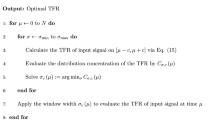Abstract
The conventional space-time adaptive processing (STAP) method such as the typical sample matrix inversion (SMI)-based STAP method is difficult to implement for a practical system because intense computational complexity arises in calculating the inversion of a space-time covariance matrix directly. According to the block Hermitian matrix property of space-time covariance matrix, a new pulse-order recursive method is proposed in this paper to calculate the inverse covariance matrix for the STAP adaptive weight, which can reduce the computational complexity significantly. The proposed method requires initially calculating the inverse covariance matrix of the first pulse-order recursively based on the block Hermitian matrix property. In the following, the inversion of space-time covariance matrix is obtained recursively based on the previous pulse-order inverse covariance matrix. Next, the STAP adaptive weight is calculated based on the inversion space-time covariance matrix previously obtained. Compared with the conventional SMI-based STAP algorithms, the computational complexity of the proposed method is reduced to more than 50% for the same clutter suppression performance. This method can be applied to practical systems benefiting from small computational complexity and stable clutter suppression performance.
Similar content being viewed by others
References
Klemm R. Principles of Space-Time Adaptive Processing. London: Institute of Electrical Engineering, 2006
Guerci J R. Space-Time Adaptive Processing for Radar. Artech House, 2003
Ward J. Space-time adaptive processing for airborne radar. Technical Report 1015, MIT Lincoln Laboratory, Lexington, December 1994
Reed I S, Mallet J D, Brennan L E. Rapid convergence rate in adaptive arrays. IEEE Trans Aerosp Electron Syst, 1974, 10: 853–863
Brennan L E, Mallet J D, Reed I S. Adaptive arrays in airborne MTI radar. IEEE Trans Antennas Propag, 1976, 24: 607–615
Melvin W L. Space-time adaptive radar performance in heterogeneous clutter. IEEE Trans Aerosp Electron Syst, 2000, 36: 621–633
Liu Y, Yang X, Long T. D3-STMB hybrid STAP algorithm for discrete interference suppression in nonhomogeneous clutter. IEICE Trans Commun, 2011, E94-B: 1114–1117
Wang H, Cai L. On adaptive spatial-temporal processing for airborne surveillance radar system. IEEE Trans Aerosp Electron Syst, 1994, 30: 660–670
Guerci J R, Bergin J S. Principal components, covariance matrix tapers, and the subspace leakage problem. IEEE Trans Aerosp Electron Syst, 2002, 38: 152–162
Goldstein J S, Reed I S, Zulc P A. Multistage partially adaptive STAP CFAR detection algorithm. IEEE Trans Aerosp Electron Syst, 1999, 35: 645–661
Fa R, de Lamare R C. Reduced-rank STAP algorithms using joint iterative optimization of filters. IEEE Trans Aerosp Electron Syst, 2011, 47: 1668–1684
Zhu X, Li J, Stoica P. Knowledge-aided space-time adaptive processing. IEEE Trans Aerosp Electron Syst, 2011, 47: 1325–1336
Wu Y, Tang J, Peng Y. On the essence of knowledge-aided clutter covariance estimate and its convergence. IEEE Trans Aerosp Electron Syst, 2011, 47: 569–585
Long T, Liu Y, Yang X. Pre-compensation clutter range-dependence STAP algorithm for forward-looking airborne radar utilizing knowledge-aided subspace projection. IEICE Trans Commun, 2011, E95-B: 97–105
Varadarajan V, Krolik J L. Joint space-time interpolation for distorted linear and bistatic array geometries. IEEE Trans Signal Process, 2006, 54: 848–860
Alexander S T, Ghirnikar A L. A method for recursive least squares filtering based upon an inverse QR decomposition. IEEE Trans Signal Process, 1993, 41: 20–30
Xiong J, Liao L, Wu S. Recursive algorithm of adaptive weight extraction of space-time signal processing for airborne radar. In: Proceedings of CIE International Conference of Radar, Beijing, 1996. 86–90
Cao J, Wang X. Diagonally loaded SMI algorithm based on inverse matrix recursion. J Syst Eng Electron, 2007, 18: 160–163
Cao J, Wang X. New recursive algorithm for matrix inversion. J Syst Eng Electron, 2008, 19: 381–384
Beau S, Marcos S. Range dependent clutter rejection using range-recursive space-time adaptive processing (STAP) algorithms. Signal Process, 2010, 90: 57–68
Badeau R, David B, Richard G. Fast approximated power iteration subspace tracking. IEEE Trans Signal Process, 2005, 53: 2931–2941
Manolakis D G, Ingle V K, Kogon S M. Statistical and Adaptive Signal Processing. McGraw-Hill, 2000
Golub G H, van Loan C F. Matrix Computations. Baltimore: Johns Hopkins University Press, 1996
Braham H. MCARM/STAP data analysis. Final Technical Report, AFRL-IF-RS-TR-1999-48, Vol. I–II, Air Force Research Laboratory, May 1999
Carlson B D. Covariance matrix estimation errors and diagonal loading in adaptive arrays. IEEE Trans Aerosp Electron Syst, 1988, 24: 397–401
Benjamin F A. A subspace method for space time adaptive processing. IEEE Trans Signal Process, 2005, 53: 74–82
Dong Y. Approximate invariance of the inverse of the covariance matrix and the resultant pre-built STAP processor. Research Report, DSTO-RR-0291, Defence Science and Technology Organisation, Australia, 2005
Author information
Authors and Affiliations
Corresponding author
Rights and permissions
About this article
Cite this article
Yang, X., Liu, Y. & Long, T. Pulse-order recursive method for inverse covariance matrix computation applied to space-time adaptive processing. Sci. China Inf. Sci. 56, 1–12 (2013). https://doi.org/10.1007/s11432-013-4828-3
Received:
Accepted:
Published:
Issue Date:
DOI: https://doi.org/10.1007/s11432-013-4828-3




